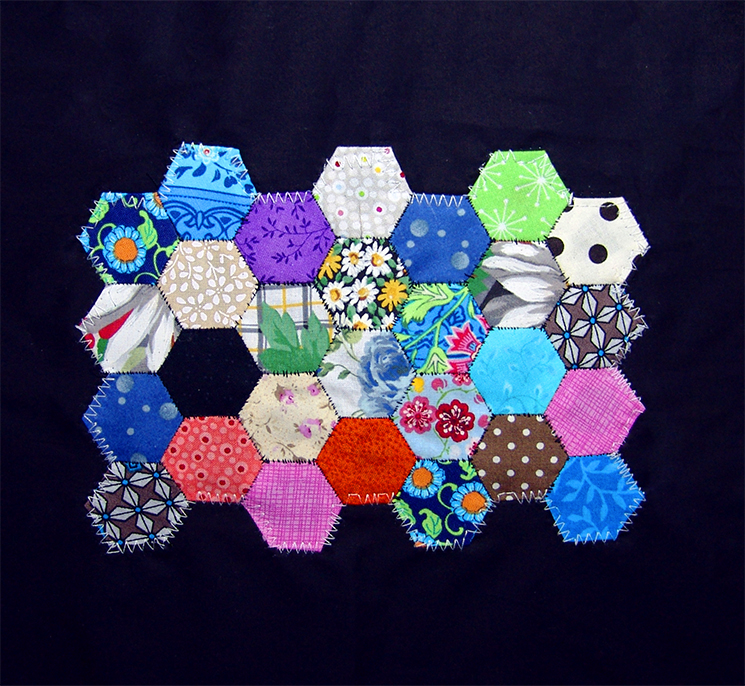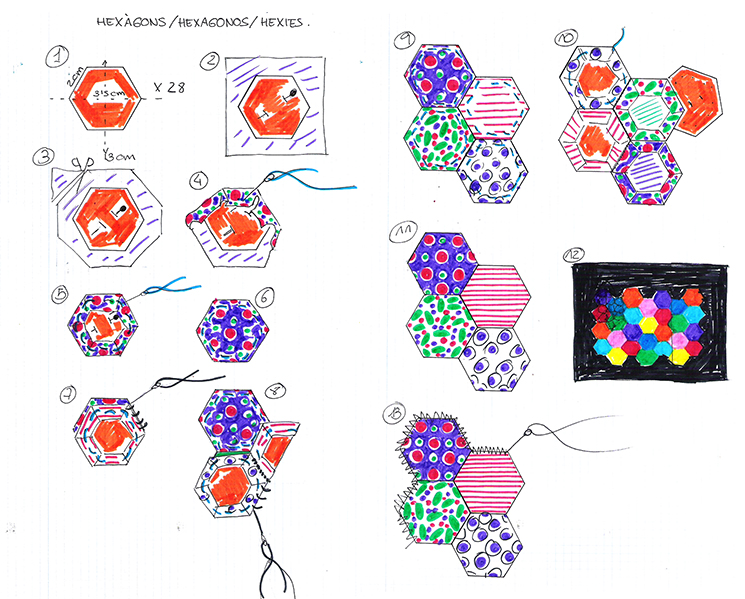HEXÀGONS FETS A MÀ: TUTORIAL PATCHWORK.
Per una vegada, Les Antònies, treballarem cosint a mà un bloc de patchwork.
Ens venia de gust fer alguna cosa amb hexàgons i, seguint les instruccions de l’Amanda del blog 3and3quarters (1&2), hem posat fil a l’agulla, mai millor dit.
Els nostres hexàgonssón petitets, perquè hem fet servir la silueta d’un regle molt petit. Les mesures són de 3’5cm d’ampleX3cm d’alt i 2cm cada costat de l’hexàgon (1); hem dibuixat i retallat sobre cartró 28 hexàgons. Per les mesures que teníem, hem fet servir retalls de tela diferents i molt variats; feu el mateix i no us preocupeu gaire, ja l’ordenareu i coordinareu quan tingueu totes les peces fetes.
Les següents instruccions les repetirem 28 vegades. Agafarem un hexàgon de cartró i el col·locarem al centre d’un retall de tela més gran que el mateix, pel revers (2). Ho fixem amb una agulla de cap i retallem seguint la forma deixant un marge d’1cm més o menys (3). Amb un fil de color, embastarem les costures fixant-nos en les cantonades (4); quan acabem ens ha de quedar com en el dibuix (5) i (6).
Ja tenim tots els hexàgonsfolrats amb la tela i hem de decidir el disseny que volem per començar a unir-los. Aquesta part creativa us la deixem al vostre gust; nosaltres us explicarem la tècnica, només. Quan ja sabem el disseny, en ordre, cosirem a mà, hexàgon per hexàgon, amb un punt amagat. Unim per els costats (7), encarant-los. Quan tenim uns quants cosits, la cosa es posa una mica difícil, però ho podem fer, plegant sense cap mania (8).
Amb tots els hexàgonscosits (9) planxem; ja podem treure les bastes, el cartró i tornem a planxar (10). Ja estan llestos (11) per aplicar on vulguem (12). Nosaltres hem cosit, aquesta vegada a màquina, per tot el voltant, amb un punt ornamental (13). Labor acabada.
Us animeu a provar aquesta tècnica? És entretinguda, però es pot fer mentre mires la teva sèrie preferida, si no pots tenir les mans quietes. A més és una manera molt bonica d’aprofitar els retalls.
A LES ABELLES ELS AGRADARIA VIURE EN UN RUSC COM AQUEST!!!
HEXÁGONOS HECHOS A MANO: TUTORIAL PATCHWORK.
Por una vez, Les Antònies, trabajaremos cosiendo a mano un bloquede patchwork.
Nos apetecía hacer alguna cosa con hexágonos y, siguiendo las instrucciones de Amanda del blog 3and3quarters (1&2), hemos puesto hilo a la aguja, nunca mejor dicho.
Nuestros hexágonos son pequeños, porqué hemos usado la silueta de una regla muy pequeña. Las medidas son de 3’5cm de anchoX3cm de alto y 2cm cada lado del hexágono(1); hemos dibujado y recortado sobre cartón 28 hexágonos. Para las medidas que teníamos, hemos usado retales de tela diferentes y muy variados; haced lo mismo y no os preocupéis, ya ordenaréis y coordinaréis cuando tengáis todas las piezas hechas.
Las siguientes instrucciones las repetiremos 28 veces. Cogeremos un hexágono de cartón y lo colocaremos en el centro de un retal de tela más grande que el mismo, por el reverso (2). Lo fijaremos con un alfiler y recortaremos siguiendo la forma dejando un margen de 1cm más o menos (3). Con un hilo de color, hilvanaremos las costuras fijándonos en las esquinas (4); cuando acabemos nos ha de quedar como en el dibujo (5) y (6).
Ya tenemos todos los hexágonos forrados con la tela y tenemos que decidir el diseño que queremos para empezar a unirlos. Esta parte creativa os la dejamos a vuestro gusto; nosotras os explicaremos solo la técnica. Cuando ya sabemos el diseño, en orden, coseremos a mano, hexágono por hexágono, con un punto escondido. Unimos por los lados (7), encarándolos. Cuando tenemos unos cuantos cosidos, la cosa se pone un poco difícil, pero lo podemos hacer, plegando sin ninguna manía (8).
Con todos los hexágonos cosidos (9) planchamos; ya podemos sacar los hilvanes, el cartón y volvemos a planchar (10). Ya están listos (11) para aplicar donde queramos (12). Nosotras hemos cosido, esta vez a máquina, por todo alrededor, con un punto ornamental (13). Labor acabada.
¿Os animáis a probar esta técnica? Es entretenida, pero se puede hacer mientras miras tu serie preferida, si no puedes tener las manos quietas. Además es una manera muy bonita de aprovechar los retales.
¡¡¡A LAS ABEJAS LES GUSTARÍA VIVIR EN UNA COLMENA COMO ESTA!!!
HEXAGONS HAND MADE: TUTORIAL PATCHWORK.
For once, Les Antònies, we will work hand-sewing a patchworkblock.
We wanted to do something with hexagons and, following the instructions of Amanda»s blog 3and3quarters (1&2), we have made thread the needle, never better said.
Our hexagons are very small, because we used the silhouette of a small ruler. The measurements are 3’5cm wideX3cm high and 2cm each side of the hexagon (1); we have drawn and cut on cardboard 28 hexagons. By the measures that we had, we used different and varied fabric scraps; do the same and not worry too much, because you arrange and coordinate when you have all the pieces made.
The following instructions we will repeat 28 times. We will take a hexagon of carton and place it in the centre of a scrap larger than the hexagon, in the wrong face (2). We will post it with a pin and cut following the form leaving a margin of 1 cm more or less (3). With a thread of colour, we tacking the seams fixing the corners (4); at the end, it should be as in the drawing (5) and (6).
We already have all the hexagons lined with fabric and you need to decide what design you want to start to join them. This creative part we leave to your liking; we will explain the technique, only. When we already know the design, arranged, we hand-sewing, hexagon to hexagon, with a hidden point. Join to the sides (7), facing them. When we have a few sewn, the thing gets a little tricky, but we can do it, folding without any problem (8).
With all the hexagons sewn (9) we iron; we can remove the tacks, the cardboard and returned to iron (10). They are already ready (11) to apply where you want (12). We have sewn, this time by machine, all around, with an ornamental point (13). Work completed.
Do you decide to try this technique? It is entertaining, but it can be done while watching your favourite series, if you can»t get your hands still. It is also a very nice way to take advantage of the fabric scraps.
BEES WOULD LIKE TO LIVE IN A HIVE AS THIS ONE!!!











